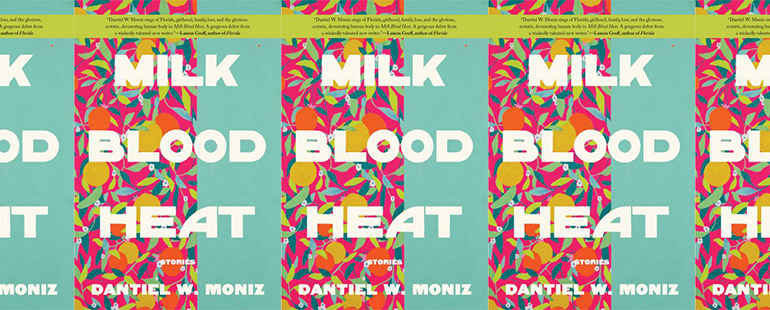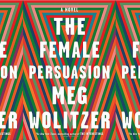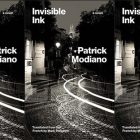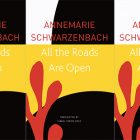Milk Blood Heat by Dantiel Moniz

Milk Blood Heat
Dantiel Moniz
Grove Atlantic | February 2, 2021
Dantiel Moniz’s sparkling debut story collection, Milk Blood Heat, is vibrant and alive, full of energy and desire and with a sharp focus on the body. Two girls float adrift in the sea. A naked man stands on his bathroom scale. A woman looks at the remains of her miscarriage. Milk, blood, or heat appear in every story, functioning as the beating heart of the book. Through these three elements—each of them so clearly connected to the body—Moniz creates an honest, unflinching look at her characters’ innermost thoughts and desires.
Milk, blood, and heat are present in the opening of the titular story, which was first published in Ploughshares, when Ava and Kiera, two thirteen-year-old best friends, mix their blood together in a show of friendship: “‘Pink is the color for girls,’ Kiera says, so she and Ava cut their palms and let their blood drip into a shallow bowl filled with milk, watching the color spread slowly on the surface, small red flowers blooming.” The image is striking and powerful, and even more so when we learn that Kiera is white and Ava is Black. The girls then drink the milk: “They wipe pink froth from their faces with the backs of their arms and sit still for a moment, solemn in the wake of what they’ve just done.” This idea of consuming the self occurs often throughout the collection. The two girls are joined—not simply by mixing their blood but by swallowing it, each literally drinking the other. Ava feels Kiera’s blood within in her, “pumping hard in her veins—a howling, creating heat.” Moniz’s prose is full of heat, too: you can practically feel the blood throbbing in Ava’s body and understand how fully the two girls have become one.
When Ava hugs Kiera’s mother, she wonders if she can feel Keira’s blood within her. Here, as in many of the collection’s stories, Moniz explores the close bond of mother-child relationships. A prism of sorts exists to examine these relationships: sometimes the point-of-view character is the mother, or a mother-to-be, whereas at other times the relationship is examined by a daughter. In “The Hearts of Our Enemies,” the only story in the collection with a POV that switches between characters, we get to know Frankie and her teenage daughter Margot. Their shaky relationship is not atypical, perhaps, but the shifting POV allows us to see it from both sides, to understand what mother and daughter both know and what they misunderstand:
Frankie found herself suddenly overwhelmed by the girl, a creature once of her own body and now nearly eighteen and too big to sit on her lap or let go of a grudge easily. What a gorgeous thing she’d made. She tried to remember what it was like before her daughter despised her, the small years when she was revered as a Mother-God, and said to the girls, “Good morning!” though it wasn’t anymore.
How deftly Moniz positions that “What a gorgeous thing she’d made” in between the two longer sentences, allowing the phrase the central spot. For not only does milk join the mother and child, but so does pregnancy. Again, we see the absorption of one body by another, and the difficulties that arise when the two are no longer one.
This complicated relationship is explored further in “Thicker Than Water,” where Montiz examines the bond between fathers and daughters. At their mother’s behest, Cecilia and her brother take their father’s ashes to New Mexico. Cecilia’s mother hands her the urn with her father’s ashes:
This is Arlo, our father, and he is everywhere in me. He taught me how to cook, how to type, how, when walking, not to look down at my feet. He had always been precise with me and did not treat me as a child. He told me the names of things; when there was death he called it death, and when he tucked me in at night he would say into my ear, Por la sangre, and wouldn’t leave until I repeated it back. Until I made him believe that I believed it. I had loved him and was frightened of him, as he thought all good daughters should be.
It is telling that he is “in” Cecilia, the uncomfortable image of a father in his daughter. Later in the story, Cecilia learns that “por la sangre,” meaning blood is thicker than water, and the Arabic translation is “blood is thicker than milk.” If milk is a link between mother and child, then blood is a link between a father and his offspring. The Arabic translation underscores the way that Cecelia’s memories of her father weigh heavily upon her. Later in the story, Cecilia remembers a moment with her father: “They’re having sex, Arlo tells me, his hand a dry heat on my belly, and when he says it, something I don’t have language for enfolds me like a womb.” At moments like this—and there are many—the reader feels the story in their body as they read; Moniz makes us look directly at the source of trauma in order to share the pain.
Indeed, Moniz’s ebbing and flowing prose makes the sentences feel as alive as the stories themselves. It is fitting that the title of the collection is a series of words, rather than an image or a phrase. Moniz uses language to describe the often indescribable: the way that bodies feel, the way that thoughts rise and fall. In “Tongues,” the focus is partially on language as the story follows Zey, an avid student, who loves words and their meanings. The story is written in present tense, and Moniz uses a flash-forward to illuminate Zey’s desires:
She knows that soon she’ll walk through the door of eighteen, pass through her parents’ house into something she can’t quite see but can sense the murky edges of—the shape of her future. She will pack all her knowledge, strings of inky words—pansophy, verisimilitude—into canvas bags and wear them on her womanly body, where they’ll glow like Tahitian pearl, and when she leaves, her parents will wash their hands of her.
This merging of the mind and the body—the words worn like jewels—is striking. So often in the collection, there is a tension between the mind and the body, characters often thinking more than they act, feeling trapped in bodies and situations out of their control. By using the flash-forward, Moniz is able to bring the two together, showing how Zey’s imagined future will look compared to her present. Moniz uses flash-forwards often, allowing the reader to see how the events of a story will inform the future, or how a character’s desires will lead them to action. She examines the links between today and tomorrow, between the child and the adult, questioning how childhood desires manifest in later years.
This question echoes among the stories, and while each story in Milk Blood Heat stands beautifully on its own, the themes and tropes echoed throughout allow this collection to become a whole greater than its parts. At the end of “An Almanac of Bones,” Sylvie imagines what people will think, 100 years later, when they find her bones: “They would never quite get it because they couldn’t see the whole: my fierce weirdness or the restless current that circled my spine.” In this collection, we get to see the whole, the mind and body fitting together, in striking stories brimming with life.



